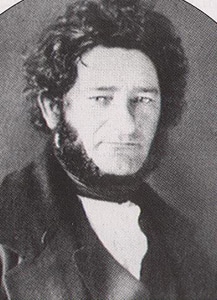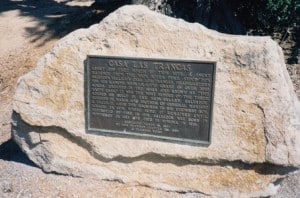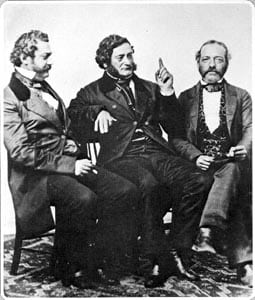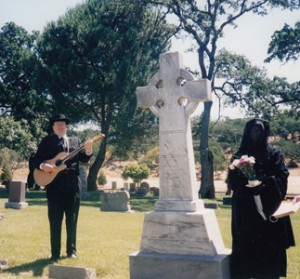California History, Latino and Hispanic History, People, Tidings
Remembering Salvador Vallejo
This is an excerpt of an article written by Nancy Brennan, local historian known as “The Cemetery Lady” for her Tulocay Cemetery Tour. It was first published in the Vol. 21, No. 1 edition of Tidings, our quarterly newsletter. To get your copy of Tidings, become a member today!
Check out our online catalogue to see what we have on Salvador Vallejo.
 California was still a Spanish colony when Salvador Vallejo was born two hundred years ago in January 1814. This volatile era was the background for the story of the two Vallejo brothers, Mariano and Salvador, who were born in Monterey, then the capital of Alta California. By 1822 Mexico had won its independence from Spain…Mariano was sent to Sonoma as Military Commander and Director of Colonization of the Northern Frontier in 1833. Salvador followed his older brother, and though his story has been overshadowed by his more famous sibling, Salvador was Mariano’s aide, assistant, and confidante as they played out their roles at the high water mark of Spanish/Mexican influence in Northern California before 1846, and later when California became part of the United States.
California was still a Spanish colony when Salvador Vallejo was born two hundred years ago in January 1814. This volatile era was the background for the story of the two Vallejo brothers, Mariano and Salvador, who were born in Monterey, then the capital of Alta California. By 1822 Mexico had won its independence from Spain…Mariano was sent to Sonoma as Military Commander and Director of Colonization of the Northern Frontier in 1833. Salvador followed his older brother, and though his story has been overshadowed by his more famous sibling, Salvador was Mariano’s aide, assistant, and confidante as they played out their roles at the high water mark of Spanish/Mexican influence in Northern California before 1846, and later when California became part of the United States.
 Salvador owned land in the Napa Valley. Rancho de Napa, granted in 1838, was five square leagues, or 21,650 acres of land extending from what is now north Napa along the west side of the Napa River to Yountville…The site of one of Salvador Vallejo’s three Napa adobe houses was north of the Trancas/Old Soscol Way intersection on the land behind where the Chevron Station is today. This was the headquarters for his Rancho de Napa, and was known as “the Happy Casa.” Salvador later gave the hacienda to his oldest son, Ignacio, who lived in it until it burned in 1919. Salvador also received another league and a half of land called Rancho Yajome, located on the east side of the Napa River near Rancho de Napa. The adobe structure which Salvador built there as headquarters for his ranch foreman was later converted into a residence on the Longwood Ranch. It was destroyed by fire in the 1970s…
Salvador owned land in the Napa Valley. Rancho de Napa, granted in 1838, was five square leagues, or 21,650 acres of land extending from what is now north Napa along the west side of the Napa River to Yountville…The site of one of Salvador Vallejo’s three Napa adobe houses was north of the Trancas/Old Soscol Way intersection on the land behind where the Chevron Station is today. This was the headquarters for his Rancho de Napa, and was known as “the Happy Casa.” Salvador later gave the hacienda to his oldest son, Ignacio, who lived in it until it burned in 1919. Salvador also received another league and a half of land called Rancho Yajome, located on the east side of the Napa River near Rancho de Napa. The adobe structure which Salvador built there as headquarters for his ranch foreman was later converted into a residence on the Longwood Ranch. It was destroyed by fire in the 1970s…
Salvador Vallejo was seven years younger than Mariano. He received a typical education for an upper class boy of Spanish ancestry. He learned to read and write in a private school. An article about him by historian Myrtle M. McKittrick says, “He also took music lessons from a talented Native American named Cantor, and as long as he lived he liked to sing the ancient ballads which Cantor had taught him.”[1] In the same article McKittrick quotes Guadalupe Vallejo, Salvador’s niece, who wrote this in 1890 about the training of a young caballero:
An educated young gentleman was well skilled in many arts and handicrafts. He could ride, of course, as well as the best cowboy of the Southwest, and with more grace: and he could throw the lasso so expertly that I have never heard of any American who was able to equal it. He could also make soap, pottery and bricks, burn lime, tan hides, cut out and put together a pair of shoes, make candles, roll cigars and do a great number of things that belong to different trades.[2]
Salvador’s first official assignment from his brother was a particularly romantic one…While in San Diego, Mariano Vallejo had fallen in love with a beautiful young woman of Spanish descent named Benecia Francesca Maria Felipa Carrillo… Mariano Vallejo had not been able to make the trip back to San Diego to escort his bride north. So in the spring of 1833, he dispatched Salvador with an escort of 20 troopers to bring his bride home. Platon Vallejo said his mother never tired of telling of the four week trip along El Camino Real, with her handsome escorts resplendent in their new uniforms and the wildflowers in bloom…[3] While visiting San Diego, Salvador fell in love with Maria de la Luz Carillo, Benecia’s sister. After they were wed, they made their home in Sonoma. The companionship must have been a great joy for the two sisters in a lonely pueblo outpost…Later…he moved his wife and family to their adobe, Casa Las Trancas, which was built in the early 1840s…
 Both brothers took part in a campaign against a group of hostile Yolo Indians. Their ally was the legendary Chief Solano, who had become a trusted friend, and 200 warriors from his Suisun tribe. In January 1839 Salvador was named commander of the post and captain of the infantry at Sonoma. An 1842 account describes a camp of 1,200 Solano Indians at Huichica (in the Carneros region), where Salvador was training the men to be soldiers…Salvador Vallejo has been accused of cruel behavior in his battles with the Native Americans. It is hard to separate truth from fiction, particularly when many accounts were reported by visitors with scant knowledge of the culture of the area…Salvador may not have had the genial personality of his older brother, for he was a military man by temperament and profession. But stories also exist, particularly from his later years, which portray him as a kind man full of charm and culture and beloved by his friends and family…
Both brothers took part in a campaign against a group of hostile Yolo Indians. Their ally was the legendary Chief Solano, who had become a trusted friend, and 200 warriors from his Suisun tribe. In January 1839 Salvador was named commander of the post and captain of the infantry at Sonoma. An 1842 account describes a camp of 1,200 Solano Indians at Huichica (in the Carneros region), where Salvador was training the men to be soldiers…Salvador Vallejo has been accused of cruel behavior in his battles with the Native Americans. It is hard to separate truth from fiction, particularly when many accounts were reported by visitors with scant knowledge of the culture of the area…Salvador may not have had the genial personality of his older brother, for he was a military man by temperament and profession. But stories also exist, particularly from his later years, which portray him as a kind man full of charm and culture and beloved by his friends and family…
Although the United States had declared war on Mexico in May 1846 supposedly because of border clashes in Texas, the conflict had not spread to California. Fearing they might be driven from what they considered their land, a group of 33 men confronted Mariano Vallejo at his Sonoma adobe on June 14, 1846. No shots were fired in this first act of the Bear Flag Revolt, but eventually “the Bears” took Vallejo captive, with his French aide Victor Prudhon, his brother Salvador, and his brother-in-law Jacob Leese (an American). The Mexican flag was lowered and the homemade Bear Flag of the California Republic was raised, to be replaced just 25 days later when word was brought to Sonoma that the United States Navy had raised the Stars and Stripes over the Custom House in Monterey. Ironically, in jailing Mariano Vallejo, the Bear Flaggers had captured one of the most pro-American of the Mexican Californians.
The prisoners who had been taken to Sutter’s Fort in Sacramento were held there for two months. Salvador was upset by seeing his brother asleep on the damp floor with no blanket. According to McKittrick, he said, “I did not feel the situation on my own account, for I was used to ‘rough it’ as Mark Twain calls the life of a mountaineer. But my heart grieved for my brother. I went back to the days in which the house of General Vallejo was the rendezvous of every foreigner who visited California. I cursed the days in which our house dispensed hospitality to a race of men deaf to the call of gratitude, so perfect strangers to good breeding.”[4] Salvador’s wife and children were left at their Casa Las Trancas in the Napa Valley. The Casa was visited at least twice by rebels searching for arms and horses. The Native Americans on the property remained loyal to the Vallejos, and helped hide valuables, including Salvador’s prize Arabian stallion. Myrtle McKittrick quotes Salvador on his return home from Sutter’s Fort, “in the course of two days I reached Napa. There I found my desolate wife and four young children in a state bordering on distraction; my property scattered to the four winds, for whatever they could not carry away they had taken good care to destroy.”[5]
Salvador ?led a claim for $53,100 in damages but was paid only $11,700 by the United States government…When the trickle of immigrants turned into a flood during the Gold Rush, the Californios had even more difficulty defending their property titles. Salvador filed claims for his land, but while he waited for the courts and land commission to act the squatters moved in and his grain crops were repeatedly lost to fires, likely set by arsonists. He finally gave up and sold most of the rest of his Napa land and deposited the money in three San Francisco banks, all of which failed soon thereafter. By this time, he had been reduced to desperate financial straits, but chose to live quietly on what little property he still owned.
When the Civil War broke out, Salvador accepted a commission as Major of the First Battalion of Native Cavalry from Governor Leland Stanford…The battalion was sent to Arizona, but never saw any real fighting, much to Salvador’s disappointment. He resigned his commission in 1865. Salvador Vallejo’s active life had taken a toll on him physically. Perhaps this is why he eventually left his home in Napa and lived out his last days in his brother’s new home, Lachryma Montis (“Tears of the Mountain”) in Sonoma. Henry Cerruti, who came to Sonoma in 1873, as an agent of historian Hubert Howe Bancroft, describes Salvador’s difficulty walking.[6] He managed always to stand straight, but refused to have his picture taken in later years…
 In death on February 18, 1876, Salvador Vallejo finally returned to the Napa Valley. He and his wife, Maria de la Luz Carillo Vallejo, are buried at Tulocay Cemetery…Some of their children are also buried there, including daughter Viola Z. Holmes and her husband. Many descendants of the Vallejos still live in the San Francisco Bay Area today.
In death on February 18, 1876, Salvador Vallejo finally returned to the Napa Valley. He and his wife, Maria de la Luz Carillo Vallejo, are buried at Tulocay Cemetery…Some of their children are also buried there, including daughter Viola Z. Holmes and her husband. Many descendants of the Vallejos still live in the San Francisco Bay Area today.
[1] M. M. McKittrick. “Salvador Vallejo.” California Historical Society Quarterly, XXIX 4 (December 1950): 309-331.
[2] Ibid.
[3] Platon Mariano Guadalupe Vallejo. Memoirs of the Vallejos. Fairfield, CA.: James D. Stevenson, 1994.
[4] M. M. McKittrick. Salvador Vallejo, Last of the Conquistadores. Arcata, CA, 1948.
[5] McKittrick, “Salvador Vallejo.”
[6] Henry Cerruti. Ramblings in California: The Adventures of Henry Cerruti. Berkeley: Friends of the Bancroft Library, 1954.

